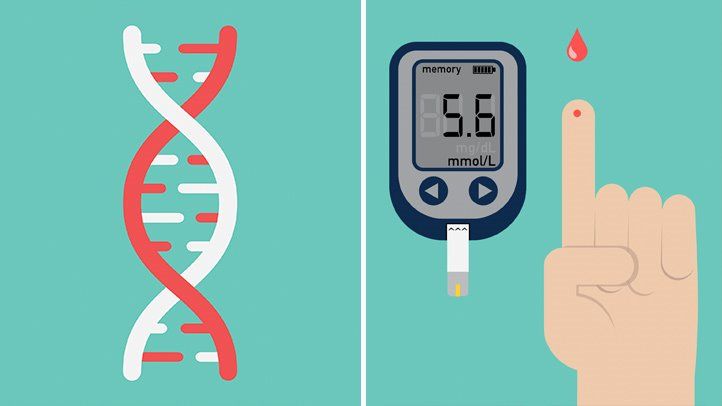
Genetic factors can make some people more prone to some types of diabetes. However, a person does not inherit the condition, and there may be ways to reduce the risk. Knowing how type 2 diabetes affects family members, for example, can motivate a person to take steps to prevent it.
In addition, awareness of family history can help in early diagnosis. As a result, a person can help prevent some complications.
The role of genetic factors varies in different types of diabetes. In type 2, for example, lifestyle factors are more influenced than genetics.
Knowing how genes, lifestyle, and environment influence diabetes can help a person reduce their risk of developing the condition and its complications.
Is Type 1 Diabetes Hereditary?
Type 1 diabetes is an autoimmune disease. It occurs when the body’s immune system mistakenly attacks healthy cells. This type often appears during adolescence, but a person can develop it at any age.
In the past, doctors believed that type 1 diabetes was entirely genetic. However, not everyone with type 1 diabetes has a family history.
Genetics Home Reference explains that certain genetic traits can make type 1 diabetes more likely to develop under certain conditions.
In people with this type of diabetes, scientists have found changes in the genes that produce certain proteins. These proteins play a key role in the immune system.
These genetic traits predispose a person to type 1 diabetes, and certain factors can trigger the condition. Once a person has type 1 diabetes, they will have it for life.
According to the American Diabetes Association, potential risk factors include:
Cold Weather: Type 1 diabetes is more likely to appear in winter than in summer. It is also more common in colder climates.
Viruses: Researchers believe that certain viruses can trigger type 1 diabetes in people who are susceptible. These viruses include measles, mumps, Coxsackie B, and rotavirus.
Early Feeding: Breastfeeding as a baby may reduce the chance of developing type 1 diabetes later in life.
People with type 1 diabetes can have autoimmune antibodies in their blood for years before they develop symptoms.
The condition may develop over time, or something may have to activate autoimmune antibodies before symptoms appear. After this activation, symptoms begin to appear rapidly over days or weeks.
Is Type 2 Diabetes Hereditary?
Type 2 diabetes is the most common type, accounting for about 90-95 percent of all diabetes cases in the United States, according to the Centers for Disease Control and Prevention (CDC).
As with type 1 diabetes, people with type 2 often have a close family member with the condition.
However, while genetic factors may play a role, experts believe that lifestyle factors, including diet and exercise, have the most significant impact.
In addition to family history, other factors increase the risk of developing type 2 diabetes, including:
- an age of 45 years or older
- excess weight, a high body mass index (BMI), or obesity
- a history of cardiovascular disease
- depression
- a sedentary lifestyle that involves limited physical activity
- polycystic ovary syndrome, which many know as PCOS
- high blood pressure
- high levels of fat and cholesterol in the blood
- a history of gestational diabetes, which occurs during pregnancy
Certain groups of people are also at a higher risk of developing type 2 diabetes. These include African-American, Alaska Native, American Indian, Asian-American, Hispanic-American, Native Hawaiian, and Pacific Islander.
According to the National Institute of Diabetes and Digestive and Kidney Diseases, a person’s race, ethnicity, or both can also affect BMI, which can trigger type 2 diabetes risk.
For whites, Hispanics, and African Americans, the excess risk begins at a BMI of 25. For Asian Americans, this includes a BMI of 23. For Pacific Islanders, risk starts at a BMI of 26.
People with two or more risk factors are more likely to develop type 2 diabetes.
Gestational Diabetes
Gestational diabetes, which occurs in up to 14 percent of all pregnancies in the United States, usually has no symptoms, but it can increase the risk of delivery complications and other problems.
Gestational diabetes usually goes away after birth, but type 2 diabetes can develop again, sometimes shortly after the pregnancy ends or many years later.
Doctors aren’t sure why this happens, and there’s no clear pattern of inheritance. However, a woman with gestational diabetes often has a family member with diabetes, usually type 2.
Diabetes Insipidus
Diabetes insipidus is a completely different condition than type 1 or type 2 diabetes. Both are types of diabetes mellitus, and they affect either the pancreas’s production of the hormone insulin or the body’s ability to use that insulin.
Diabetes insipidus, however, does not affect how the body uses insulin or blood sugar. Instead, it is the result of a malfunction in the pituitary gland and affects the production of the hormone vasopressin. This changes the water balance in the body.
There are two types of diabetes insipidus:
Nephrogenic diabetes insipidus, a genetic condition that develops after a genetic mutation in a parent.
Neurohypophyseal diabetes insipidus, which is partly hereditary and genetic, but can also result from other factors, such as injury or tumors.
A person with diabetes insipidus can become dehydrated very easily. They will need to drink lots of water and urinate frequently. In someone with this condition, dehydration can lead to confusion, low blood pressure, seizures, and coma.








